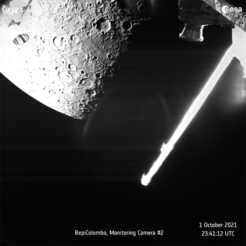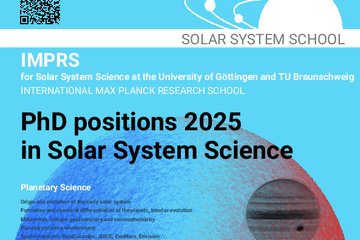BepiColombo: A First Glimpse of Mercury
During the twin probe’s first flyby of Mercury, the scientific instruments were able to take a first look at their future working environment.
At a distance of only 199 kilometers, the European-Japanese twin probe BepiColombo flew past Mercury last Saturday, October 2. It was the first of a total of six such fleeting encounters with Mercury before BepiColombo enters orbit at the end of 2025. Some of the scientific instruments to which the scientific and technical teams at the Max Planck Institute for Solar System Research (MPS) in Germany contributed were also in operation during last weekend's flyby, giving them the opportunity to record measurement data under "Mercury conditions" for the first time. Since the subsequent orbit will be at least twice the distance from Mercury, the flyby provided BepiColombo with an unusually close view of its target planet.

It is an arrival in installments: Before the twin probe of the European and Japanese space agencies ESA and JAXA finally reaches Mercury at the end of 2025 and then orbits it for the rest of the mission duration, the mission calendar includes six flybys. Step by step, these maneuvers slow down the spacecraft preparing it to enter orbit. The first of these flybys was now successful: At 1:34 (CEST) on October 2, the spacecraft whizzed by at a distance of just 199 kilometers. The on-board cameras, which were designed to monitor the spacecraft's status from various perspectives, were able to capture the first images of the planet.
Many of the scientific instruments aboard the two probes were also turned on. The maneuver brought them within 199 kilometers of Mercury's surface - significantly closer than the orbits planned from 2025, which will maintain a minimum distance of 400 kilometers from the planet. In particular, the flyby gave the so-called in situ instruments, which do not look at the planet itself but measure particles and magnetic fields in its vicinity at their own observation site, access to a region they will not reach later. However, because the two probes are currently still stacked on top of each other before they will separate once they finally arrive at Mercury, some of the instruments had a limited field of view.
Above all, the flyby allowed the instrument teams to get to know the measuring conditions at Mercury. The Mercury Imaging X-ray Spectrometer (MIXS), for example, tracks the composition of Mercury's surface. To determine this, the instrument examines the characteristic X-ray radiation that atoms and molecules on the surface emit into space when they are exposed to sunlight. BepiColombo whizzed past Mercury's night side last weekend, but still the MIXS team's measurements were important for the rest of the mission. "MIXS was able to measure the high-energy solar background radiation, i.e., the X-ray radiation before, during and after the flyby on the far side of the planet," MPS scientist Dr. Martin Hilchenbach, who is part of the MIXS team, explains. In future observations from the dayside, the team can then factor out this background radiation.
Other instruments were also able to familiarize themselves with their future working environment during the flyby. For example, the MPPE-MSA (Mercury Plasma Particle Experiment - Mass Spectrum Analyzer) mass spectrometer and the SERENA-PICAM (Search for Exospheric Refilling and Emitting Natural Abundances Experiment - Planetary Ion Camera) ion camera identified energetic, charged particles in the planet's environment. Further evaluation of the measurement results is still pending.
Unlike Earth, Mercury, which is much smaller, does not have a dense atmosphere, but only a very thin gas shroud, the so-called exosphere. The particles that cavort there come from the solar wind, the steady stream of particles from the Sun, or are emitted into space from Mercury's surface. "Exactly how the exosphere is formed, how it evolved and how it is maintained is still unclear," says MPS scientist Dr. Harald Krüger, who is part of the SERENA and MPPE instrument teams. "Analyzing the ions in the exosphere using the particle spectrometers on both spacecraft will help to better understand the processes within it," he adds.
Mercury's weak magnetic field plays an important role in this. At its surface, its strength is only about one percent of the terrestrial value. Nevertheless, as on Earth, it creates an extended magnetosphere around the planet in which charged particles are trapped. The MPO-MAG instrument, among others, is designed to help understand how the magnetic field is created deep inside the planet. The magnetometer, which was developed and built under the leadership of the TU Braunschweig and in which MPS researchers are scientifically involved, used the flyby to make first measurements of the magnetic field. In doing so, the flight path was particularly favorable. "For the measurement of the internal magnetic field, the close distance to the planet is particularly important. The fact that BepiColombo passed over regions south of the equator that could not be covered by NASA's Messenger spacecraft also raises hopes for new insights," said MPS scientist Dr. Johannes Wicht of the MPO-MAG team. Messenger studied Mercury from 2011 to 2015.
An opportunity for a second look at Mercury and its unusual particle and magnetic field environment will be provided by BepiColombo's next flyby in June next year. Further maneuvers of this kind are planned for June 2023, September and December 2024 and January 2025.
About the mission
The BepiColombo twin spacecraft, operated by the European and Japanese space agencies ESA and JAXA, launched into space on Oct. 20, 2018. It consists of two probes, the Mercury Planetary Orbiter and the Mercury Magnetospheric Orbiter, which fly stacked on top of each other during the journey to Mercury. MPS has contributed hardware to the BELA (BepiColombo Laser Altimeter), MIXS (Mercury Imaging X-ray Spectrometer), MPPE (Mercury Plasma Particle Experiment), and SERENA (Search for Exospheric Refilling and Emitted Natural Abundances Experiment) instruments, and is scientifically involved in the MPO-MAG magnetometer and the MDM (Mercury Dust Monitor) instrument. The spacecraft will enter orbit around the planet in late 2025.












